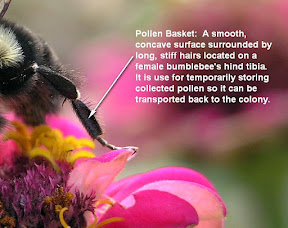Common Eastern Bumble Bee - Bombus impatiens
(Photo: Marvin Smith on 11/8/09)
Most everyone knows that bees visit flowers and collect nectar. Humans value the nectar product and call it honey. Bees also collect pollen. To the bee, pollen is as important as nectar. Pollen is the primary food for developing bee larvae.
 Female bees (queens and workers) in family Apidae (honey bees, carpenter bees, bumblebees and several lesser known groups) have specialized structures called pollen baskets (corbicula) used for temporarily storing collected pollen so it can be transported back to the nest/colony. The pollen basket is a smooth, concave structure surrounded by long, stiff hairs located on the tibia of the bee's two rear legs. As the bee visits flowers, she accumulates pollen all over her body. She uses her legs to aggregate the pollen and transfer it to her pollen basket. It may look as if a bee simply has hairy legs, but some of those hairs (setae) are actually combs and brushes used for transferring pollen. The pollen is combed, pressed, compacted, and transferred to her pollen basket. Honey and/or nectar is used to moisten the dry pollen so it will stay in place.
Female bees (queens and workers) in family Apidae (honey bees, carpenter bees, bumblebees and several lesser known groups) have specialized structures called pollen baskets (corbicula) used for temporarily storing collected pollen so it can be transported back to the nest/colony. The pollen basket is a smooth, concave structure surrounded by long, stiff hairs located on the tibia of the bee's two rear legs. As the bee visits flowers, she accumulates pollen all over her body. She uses her legs to aggregate the pollen and transfer it to her pollen basket. It may look as if a bee simply has hairy legs, but some of those hairs (setae) are actually combs and brushes used for transferring pollen. The pollen is combed, pressed, compacted, and transferred to her pollen basket. Honey and/or nectar is used to moisten the dry pollen so it will stay in place.Bumblebee with loaded pollen basket.
(Photo: Beatriz Moisset via Wikimedia)
While most all bees collect pollen, not all bees have pollen baskets. Many have scopa, a general term referring to a number of different pollen-carrying modifications on the body of a bee. In most bees, the scopa is simply a particularly dense mass of elongated, often branched, hairs (or setae) on the hind leg.
Halictid bee, scopa loaded with pollen.
(Photo: Beatriz Moisset via Wikimedia )
The bumblebee in the photo at the top of the page is a Common Eastern Bumble Bee (Bombus impatiens), probably the most often encountered bumble bee in eastern North America. It has an unusually long flight season and thrives across a wide range of habitats and climates ranging from the cold temperate zone (e.g., Minnesota) to the warm subtropics (south Florida). B. impatiens can be found in rural, suburban and urban environments. There are isolated pockets of Common Eastern Bumble Bees outside of it's normal range -- like California -- because it escapes from commercial greenhouses where it is used for pollination. The bee has no pollen because this photo was taken in early November when pollen sources were few and far between. She was lucky to find a few scraggly zinnias still blooming in our garden.
Sources and links:
Bombus impatiens on BugGuide
Pollen Basket on Wikipedia
Scopa on Wikipedia
Bumblebee legs on Bumblebee.org
This work is licensed under a Creative Commons Attribution-Noncommercial-Share Alike 3.0 United States License.
.

































